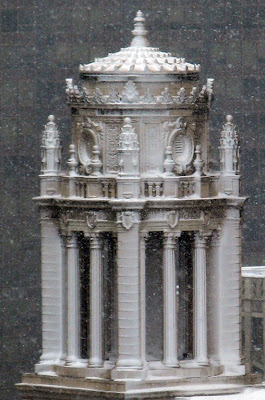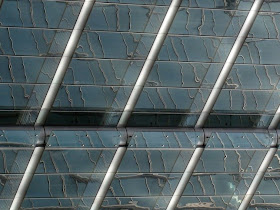 cat photograph: Yukari
cat photograph: YukariOK, not everybody has to be Kate Moss, and not every building has to be supermodel skinny. Still, Chicago, which has long heralded the Vancouver example of tall, thin buildings that bring density to the urban core while maintaining plenty of light and air circulation, talks a good story, but once there's money to be made, it all tends to go out the window. That was confirmed when Sam Assefa, director of land use and planning policy and a key advocate for the Vancouver approach, was recently unceremoniously dumped in a reorganization of Chicago's planning departments.
The Trib's architecture critic Blair Kamin has been singling out the high-rise work of architects Pappageorge Haymes for praise, but the fact of the matter is that they've provided cover to city bureaucrats inflicting major damage on the city's lakefront, especially at 600 North Lake Shore Drive. It's an handsome building, split into the two as a sop to provide more light, but it still often places the adjacent Ohio Street Beach into deep shadow.
 To be sure, it's not Pappageorge Hayme's fault, but 600 North is a structure that should never have been built. A clown car load of aldermen muscled it through as they huffed and puffed at protesting activists. "This is not a communist country!" the Trib reported then alderman Burton Natarus as railing. "You act as if this beach belongs to you personally," Bernard Stone ranted. "It belongs to all the people of Chicago," he lectured, even as he was stealing a finite and irreplaceable resource placed in his trust for the benefit of all the city's citizens - sunlight on a public beach - and handing it over for the profit of a single private developer.
To be sure, it's not Pappageorge Hayme's fault, but 600 North is a structure that should never have been built. A clown car load of aldermen muscled it through as they huffed and puffed at protesting activists. "This is not a communist country!" the Trib reported then alderman Burton Natarus as railing. "You act as if this beach belongs to you personally," Bernard Stone ranted. "It belongs to all the people of Chicago," he lectured, even as he was stealing a finite and irreplaceable resource placed in his trust for the benefit of all the city's citizens - sunlight on a public beach - and handing it over for the profit of a single private developer.
 The situation at Roosevelt Road lacks that kind of venality, but a building with the massiveness of One Museum Park still plays havoc with shadows and light. It's an interesting problem, as the original concept was to create a southern street wall to Grant Park that would complement the historic landmarked street wall down the west side of Michigan Avenue. That street wall, of course, is the opposite of Roosevelt, composed primarily of medium rise buildings standing shoulder to shoulder with nary a gap.
The situation at Roosevelt Road lacks that kind of venality, but a building with the massiveness of One Museum Park still plays havoc with shadows and light. It's an interesting problem, as the original concept was to create a southern street wall to Grant Park that would complement the historic landmarked street wall down the west side of Michigan Avenue. That street wall, of course, is the opposite of Roosevelt, composed primarily of medium rise buildings standing shoulder to shoulder with nary a gap.
 That kind of scale apparently no longer offers an adequate level of profitability, and so we get east Roosevelt Road, composed entirely of just four huge towers, one completed, one under construction, and two more planned (in the current economy, don't hold your breath). Continuous podiums at street level, portly towers above, with gaps that dissipate any visual sense of a street wall's feeling of closure. And would anyone really want a continuous street wall 60 stories high? At this point in Chicago's development, is a truly civil streetwall like Michigan Avenue any longer possible?
That kind of scale apparently no longer offers an adequate level of profitability, and so we get east Roosevelt Road, composed entirely of just four huge towers, one completed, one under construction, and two more planned (in the current economy, don't hold your breath). Continuous podiums at street level, portly towers above, with gaps that dissipate any visual sense of a street wall's feeling of closure. And would anyone really want a continuous street wall 60 stories high? At this point in Chicago's development, is a truly civil streetwall like Michigan Avenue any longer possible?
And who knows? With its rounded, stepped massing, One Museum Park, amiable and Rubensesque in a lost spaceship kind of way, could actually wind up becoming an object of affection, just like Edgar.

The Trib's architecture critic Blair Kamin has been singling out the high-rise work of architects Pappageorge Haymes for praise, but the fact of the matter is that they've provided cover to city bureaucrats inflicting major damage on the city's lakefront, especially at 600 North Lake Shore Drive. It's an handsome building, split into the two as a sop to provide more light, but it still often places the adjacent Ohio Street Beach into deep shadow.
 To be sure, it's not Pappageorge Hayme's fault, but 600 North is a structure that should never have been built. A clown car load of aldermen muscled it through as they huffed and puffed at protesting activists. "This is not a communist country!" the Trib reported then alderman Burton Natarus as railing. "You act as if this beach belongs to you personally," Bernard Stone ranted. "It belongs to all the people of Chicago," he lectured, even as he was stealing a finite and irreplaceable resource placed in his trust for the benefit of all the city's citizens - sunlight on a public beach - and handing it over for the profit of a single private developer.
To be sure, it's not Pappageorge Hayme's fault, but 600 North is a structure that should never have been built. A clown car load of aldermen muscled it through as they huffed and puffed at protesting activists. "This is not a communist country!" the Trib reported then alderman Burton Natarus as railing. "You act as if this beach belongs to you personally," Bernard Stone ranted. "It belongs to all the people of Chicago," he lectured, even as he was stealing a finite and irreplaceable resource placed in his trust for the benefit of all the city's citizens - sunlight on a public beach - and handing it over for the profit of a single private developer. The situation at Roosevelt Road lacks that kind of venality, but a building with the massiveness of One Museum Park still plays havoc with shadows and light. It's an interesting problem, as the original concept was to create a southern street wall to Grant Park that would complement the historic landmarked street wall down the west side of Michigan Avenue. That street wall, of course, is the opposite of Roosevelt, composed primarily of medium rise buildings standing shoulder to shoulder with nary a gap.
The situation at Roosevelt Road lacks that kind of venality, but a building with the massiveness of One Museum Park still plays havoc with shadows and light. It's an interesting problem, as the original concept was to create a southern street wall to Grant Park that would complement the historic landmarked street wall down the west side of Michigan Avenue. That street wall, of course, is the opposite of Roosevelt, composed primarily of medium rise buildings standing shoulder to shoulder with nary a gap. That kind of scale apparently no longer offers an adequate level of profitability, and so we get east Roosevelt Road, composed entirely of just four huge towers, one completed, one under construction, and two more planned (in the current economy, don't hold your breath). Continuous podiums at street level, portly towers above, with gaps that dissipate any visual sense of a street wall's feeling of closure. And would anyone really want a continuous street wall 60 stories high? At this point in Chicago's development, is a truly civil streetwall like Michigan Avenue any longer possible?
That kind of scale apparently no longer offers an adequate level of profitability, and so we get east Roosevelt Road, composed entirely of just four huge towers, one completed, one under construction, and two more planned (in the current economy, don't hold your breath). Continuous podiums at street level, portly towers above, with gaps that dissipate any visual sense of a street wall's feeling of closure. And would anyone really want a continuous street wall 60 stories high? At this point in Chicago's development, is a truly civil streetwall like Michigan Avenue any longer possible?And who knows? With its rounded, stepped massing, One Museum Park, amiable and Rubensesque in a lost spaceship kind of way, could actually wind up becoming an object of affection, just like Edgar.















































